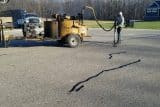Common Myths About Sealcoating and the Truth Behind Them
General
2 days ago
Sealcoating is one of the most effective ways to maintain and protect asphalt surfaces, yet there are several myths surrounding the process. These misconceptions can lead to confusion and hesitation, preventing property owners from making informed decisions.
Let’s address some of the most common myths about sealcoating and reveal the truth behind them to help you better understand its benefits.
Myth 1: Sealcoating Is Only For Aesthetic Purposes
One of the most common misconceptions is that sealcoating is simply for cosmetic improvement.
While it does enhance the appearance of your pavement by giving it a fresh, dark look, its primary purpose is to protect your asphalt from the damaging effects of the elements.

Sealcoating acts as a barrier, shielding the surface from harmful UV rays, water, oil, and chemicals. Over time, these elements can cause the asphalt to break down and deteriorate.
Sealcoating helps extend the life of your pavement by preventing cracks, potholes, and other costly damage.
Myth 2: Sealcoating Is Not Necessary For New Asphalt
Many people believe that newly laid asphalt does not need sealcoating right away. While new asphalt may look good on its own, it still needs protection from the elements.
Asphalt is porous, which means it can absorb water, oil, and other substances that can cause damage over time.
Sealcoating not only enhances the surface but also provides a protective layer that helps prevent the material from breaking down too quickly.
For best results, sealcoating should be applied to new asphalt after about six months to allow the surface to fully cure.
Myth 3: Sealcoating Will Fix Existing Cracks And Potholes
Sealcoating is not a repair solution for existing cracks and potholes. While it can help prevent further damage, it will not fix already existing problems.
If your asphalt surface has cracks or holes, it is important to address those issues before applying sealcoating.
Proper repairs, such as crack sealing and patching, should be completed first to ensure the surface is in good condition.
Once the repairs are made, sealcoating can help protect the surface and prevent future damage.
Myth 4: Sealcoating Is Only Needed Every Few Years
Another myth is that sealcoating only needs to be done once every few years. The frequency of sealcoating depends on the level of traffic, exposure to the elements, and the condition of the surface.
Generally, it is recommended to apply sealcoating every 2 to 3 years to maintain the integrity of the pavement.
If your surface experiences heavy traffic, extreme weather conditions, or constant exposure to harmful chemicals, more frequent applications may be necessary.
Regular sealcoating ensures the long-term protection and durability of your asphalt.
Myth 5: DIY Sealcoating Works Just as Well as Professional Services
While there are DIY sealcoating kits available, they do not provide the same quality or longevity as professional services. Professional sealcoating contractors have the experience, equipment, and expertise to apply the product correctly and evenly.
DIY sealcoating often results in uneven coverage, which can lead to premature wear or damage.
Additionally, professionals can identify and address any underlying issues that may need attention before applying the sealant, ensuring that the surface is properly prepared.
Protect Your Pavement With Super Seal
Sealcoating is a critical part of maintaining and protecting your asphalt surfaces, and understanding the truth behind these common myths can help you make more informed decisions.
At Super Seal in Warsaw, IN, we specialize in high-quality sealcoating and asphalt maintenance services.
If you want to protect your pavement and extend its lifespan, contact us today to schedule a consultation and learn how we can help keep your surfaces looking and performing their best.



